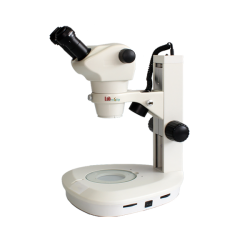
Stereo Microscope LMSM-601 has binocular viewing head at 45° inclined angle. Provided with large viewing area with extra wide field eye piece 10×(Φ20mm). It is also called as dissecting microscope which uses low magnification for observing a sample and utilizes light reflected from the surface of an object rather than transmitted through it. Focusing of specimen can be adjusted using coaxial coarse and fine focusing adjustment knob. Presence of white plastic contrast over the stage effectively reflects ambient light.
Get Quote| View Tube | Binocular, 45 ° inclined |
| Eyepiece | Standard: 10 × (Φ20 mm) |
| Objective | 0.8 to 5X |
| Working Distance | No auxiliary lens, working distance: 115 mm; Auxiliary lens AL0.5X, working distance: 211 mm; Auxiliary lens AL2X, working distance: 43.5 mm |
| Stage | A white/black plastic contrast stage |
| Magnification | Eyepiece: 10×(Φ22mm), Eyepiece 15×(Φ16mm), Eyepiece 20×(Φ12.5 mm) |
| Zoom ratio | 1:6.4" |
| Optional Auxiliary lens | Optional(Not standard): AL0.5X, AL2X |
| Depth of field | 15 mm |
| Illumination | Upper LED and bottom LED |
| Digital camera | Optional |
| Camera adapter | _ |
 It is a binocular inspection and dissection stereo microscope
It is a binocular inspection and dissection stereo microscope
 Stereo microscope works on rack and pinion focus mechanism
Stereo microscope works on rack and pinion focus mechanism
 LED light is used as source of illumination
LED light is used as source of illumination
 Superior optical performance
Superior optical performance
 Provides clear image with a broad field of view
Provides clear image with a broad field of view
 Stereo microscope main body is made up of metal
Stereo microscope main body is made up of metal
 Images can be viewed clearly on screen with digital camera
Images can be viewed clearly on screen with digital camera
 Larger samples can be analyzed
Larger samples can be analyzed
These are widely used in educational sectors, research centers, and also used to study surfaces of solid specimens It is mainly used to see large or thick objects under microscope
Get Quote for
Stereo Microscope LMSM-601
Related Products